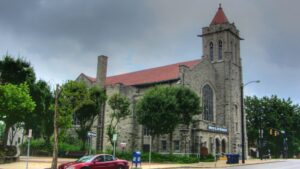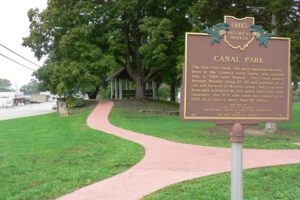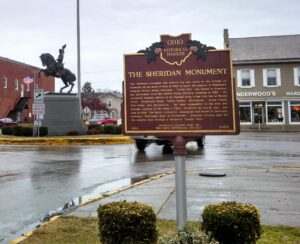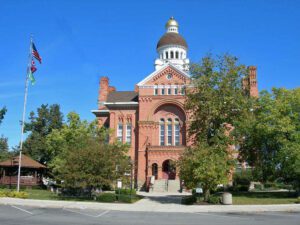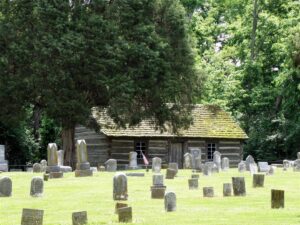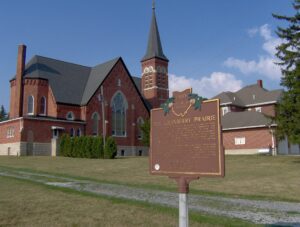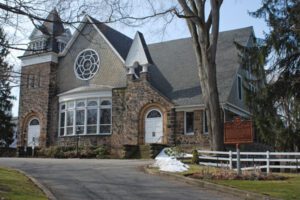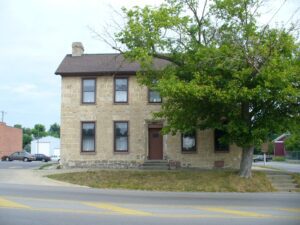, OH
Oldest Religious Congregation in north-central Ohio. First Methodist Sermon preached at the “spring” in 1809 by Rev. James Copus. Services then conducted in blockhouse, 1811; in first court house, 1813; at church home of Dr. William B. James, 1814; first church building located N.W. corner Park Avenue East and Adams, 1820; present site in 1870. All land donated by General James Hedges, a distinguished member.
, OH
The Ohio-Erie Canal, the most important development in the county’s early years, was started July 4, 1825 near Newark. The canal passed through Waverly along US 23 and portions of it can still be seen in Waverly today. Only four feet deep and bordered by tow paths with eight feet clearance, the 309 mile canal was completed in 1833 at a cost of more than $7 million.
, OH
The Sheridan monument was erected by and given to the Village of Somerset by the State of Ohio in 1905 to honor the memory of Somerset’s General Phillip Henry Sheridan. “Little Phil” was raised in Somerset and graduated from the United States Military Academy in 1852. He rendered valuable service to the Federal Army in the Civil War at Stone’s River, Missionary Ridge, Yellow Tavern, Winchester, Cedar Creek, Five Forks, and Appomattox. He later commanded in the West and became General of the Army in 1883, received his fourth star, and died in 1888. The heroic sculpture, created by Carl Heber of New York, portrays “Sheridan’s Ride” to Winchester. Somerset citizens paid for the granite base through a children’s “penny fund.”
, OH
Named for John Paulding, a Revolutionary War soldier whose capture of a British spy implicated Benedict Arnold in treason, Paulding County was formed in 1820 from the last remaining unorganized area of Ohio. Sparsely settled, it remained under the jurisdiction of Wood County until 1824 and then Williams County until 1839. Paulding’s first county seat was established at New Rochester in 1839, then moved to Charloe in 1841. Neither village exists today. Centrally-located Paulding Center became the county seat in 1851, and a courthouse was built the following year. The present courthouse, built during the region’s timber boom of the late 19th century, was designed by architect Edward Oscar Fallis and patterned after his Lenawee County courthouse in Adrian, Michigan. The four-faced Romanesque style building was completed in 1888 at a cost of $40,000. It was listed on the National Register of Historic Places in 1974.
, OH
To Commemorate the first church erected in Union Township, Miami County, Ohio, this log replica was constructed in 1976 by the Union Township 4-H Clubs and the West Milton area Camp Fire Girls. The Laura Lions Club established this historic marker which stands on the site of the West Branch Quaker Burial Grounds near the location of the original church.
, OH
The Cranberry Prairie, southwest of this marker, is a part of Ohio’s natural history. The place was named for the cranberries that grew in a swamp here prior to drainage of the area. The Cranberry Prairie was created by centuries of peat accumulation in a late Ice Age lake that formed at the base of St. John’s Moraine. Paleo-Indian or Early Archaic peoples probably killed the elk whose skeleton was dug up here in 1981. This elk was dated at approximately 7400 B.C. By the 1860s, immigrant German farmers had begun transforming the swamp into fertile farmland. “Wild Bill” Simison, a legendary inhabitant, lived in the swamp and settlers respected him for his knowledge of the area. By the turn of the nineteenth century, Granville Township School #7, St. Francis Catholic Church, and Bertke’s Store stood at the edge of the Cranberry Prairie.
, OH
Born at Wallingford, Connecticut. Served during the Revolutionary War. Proprietor, Agent, and Surveyor of the Connecticut Land Company. Appointed Judge of Trumbull County by Territorial Governor Arthur St. Clair, 1800. State Senator, Trumbull County, 1815-1816. Poland Justice of the Peace, twenty years. Moderator of St. James Episcopal Church, Boardman, 1809. First Worshipful Master of Erie Lodge No. 47, Warren, 1803, oldest lodge in the Connecticut Western Reserve and one of six lodges to form the Grand Lodge of Free and Accepted Masons of Ohio, 1809.
, OH
The Smith Tannery is the oldest original structure remaining in Greenfield. Built in 1821 by Revolutionary War veteran William Smith and his son Samuel, the tannery became a noted station on the fabled “Underground Railroad.” The structure, which also served as the family residence, was the birthplace of Dr. Samuel M. Smith, Surgeon General of Ohio during the Civil War, and Dr. William R. Smith, who personally notified Abraham Lincoln of his nomination to the presidency in 1864. The Smiths were active members of the Abolition Society of Paint Valley, which was established in 1833 in Greenfield and reorganized in 1836 as the Greenfield Anti-Slavery Society. In 1844, the Society assisted the efforts of Frederick Douglass, one of the nation’s leading abolitionists. The Society provided an important junction on the Underground Railroad, assisting many fugitive slaves to gain freedom, including, it is said, Eliza Jane Harris of Uncle Tom’s Cabin fame. The Smith Tannery was named to the National Register of Historic Places in 1978.


